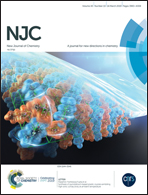The effect of the structure and oxygen defects on the simultaneous removal of NOx and soot by La2−xBaxCuO4
Abstract
La2−xBaxCuO4 (x = 0–0.6) perovskite-like oxides were prepared by the citric acid sol–gel method. Their structures and physico-chemical properties were characterized by XRD, BET, FT-IR, SEM, XPS, H2-TPR, O2-TPD, NO-TPD and soot-TPR experiments. The catalytic performances in the simultaneous removal of NOx and soot were investigated by the temperature-programmed reaction. The XRD and FT-IR results show that the substitution of Ba2+ for La3+ results in the crystal structure transformation from orthogonal La2CuO4 to tetragonal La2−xBaxCuO4 accompanied by the disappearance of the Jahn–Teller effect. Doping of Ba2+ will mainly affect two aspects: the transition of Cu2+ to Cu3+ in the orthorhombic system and the increase of the oxygen vacancy concentration in the tetragonal system. The substitution of Ba2+ in La2−xBaxCuO4 catalysts produces more active oxygen species, more Cu3+ content and better redox ability, which determines their better catalytic performance in the simultaneous removal of NOx and diesel soot particles. The La1.8Ba0.2CuO4 catalyst shows the best catalytic activity with 360 °C Ti, 510 °C Tm and 81.4% NO conversion.



 Please wait while we load your content...
Please wait while we load your content...